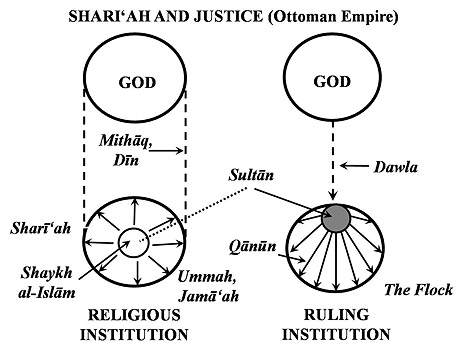Image Resource Bank
Image Gallery |  5 of 15
5 of 15 
Sharī‘ah and Justice in the Ottoman Empire
By the middle of the sixteenth-century, an ascendant Ottoman sultanate, approaching its zenith under the rule of Süleyman the Lawgiver, had conquered Anatolia, Iraq, Syria, the Hijāz (including Mecca and Medina), Egypt, North Africa, the Caucasus, and Southeastern Europe. Similar to their predecessors, the Ottoman sultāns and their network of bureaucrats presided over a body of secular qānūn law, but unlike the sacral sultanates of the early middle period, there was no separate Sunnī Jamā‘ī Imamate to confer legitimacy upon the Ottoman ruler. Much later, when the Ottoman sultān was accorded the title of caliph-imām, a corps of state-appointed legal scholars and jurists was assembled to validate his claim. At the center of this institutional body was the Shaykh al-Islam, a high-ranking dignitary appointed by the sultan who managed the religious affairs of the state. This diagram illustrates the reconfiguration of the Sunnī-Jamā‘ī Imamate during the Ottoman age, perhaps the most transparent and complete subordination of religious authority to that of the state in the political history of Islamic civilization.
Name: Sharī‘ah and Justice in the Ottoman Empire
Material: JPEG image
Size: 1366 x 1149 pixels
Date: 2009
Place of Origin: University of Chicago
Location: Chicago, IL
Source and Registration#: Professor John E. Woods

 John Woods
John Woods
Professor of Iranian and Central Asian History, and of Near Eastern Languages & Civilizations
 Alexander Barna
Alexander Barna
Outreach Coordinator, Center for Middle Eastern Studies, University of Chicago




